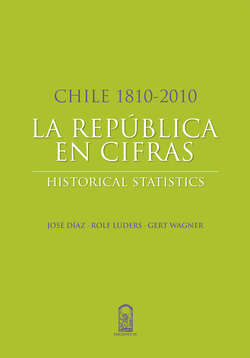Читать книгу Chile 1810-2010: La República en cifras - Jose Luis huertas Diaz - Страница 18
INTRODUCTION
ОглавлениеThis book provides a set of quantitative socio-economic indicators which describe some of the main features of the development of the Republic of Chile in the period 1810-20101. The series are organized into general chapters, which highlight, one, its commercial and financial activities, both domestically and in relation to the rest of the world; two, the work of the Treasury, mainly as reflected by its incomes and expenses; and three, a set of indicators associated to such phenomena as demographics, inflation, participation of citizens in commercial work, formal schooling and other indicators listed in the index.
All the indicators provide the basis to make substantive descriptions of aggregate development of the country, i.e., the evolution of society and of the people who inhabit its territory. Metaphorically you can imagine this as the record made by a satellite camera, located in a space ship capable of crossing time and drawing footprint captures of the work of Chilean people, finally synthesized into indicators. The contribution of individuals, regions and decentralized entities are added in composite numerical expressions, which incorporate all these contributions as indistinguishable parts of a whole.
Regional and local indicators, as well as references to specific businesses and organizations –except the Treasury– are almost nonexistent, as are names of historical actors, be they generals, ministers, presidents or bishops; actually the only names to be found correspond to authors or to organizations whose data is used in the book to build long-term indicators. However, as the metaphor suggests, aggregate figures contained in these pages take into account everything that happened in a particular time-space area in the country, reflecting, albeit anonymously and inseparably, the work of individual people and organizations, and the expressions of multiple interactions between them.
Without ignoring important contributions of decentralized or private entities, such as for example the Sociedad de Fomento Fabril (SOFOFA) and other similar business associations, the State has been in Chile the major producer of basic statistics. As a result, its capacity and effectiveness to accomplish this task, as well as its willingness to put these statistics at the disposal of the general public, are key ingredients in the construction of the data series presented in this book. At the beginning of the Republic, statistical records were limited to fiscal operations, the movement of foreign trade, and population counts. Around mid-nineteenth century the State created a department in charge of compiling statistics, initially with the idea of improving the quality and coverage of population censuses; then, in the 1860s, it begun to generate statistics of production of a wide range of basic goods and slowly, though with ups and downs, it extended the registration of all types of social phenomena. In the twentieth century another actor emerged in this field, the Central Bank, which undertook the significant task of compiling statistical indicators generated in other departments of Government, as well as to construct its own indicators.
This is not the place to describe the former work, since our knowledge is merely that of users of the basic statistical indicators generated by third parties. But it is pertinent to acknowledge that we found a significant amount of basic statistical material, which we used to construct long data series, illustrating two centuries of evolution of Chilean society. It should, finally, be mentioned, even if only in passing, that some characteristics of the evolutionary process experienced by the country have, in one way or another, complicated the production of basic statistics.
As already noted, in the second half of the nineteenth century the production of basic statistics increased, coinciding with greater fiscal activity in general. But it is not until First World War and the 1920s that the State experienced a significant change in its sphere of influence, notably increasing its presence, imposing new regulations and public activities. The process continues until the present and especially during the first half of the 20th century, the greater participation of the state in the economy was not always accompanied by a parallel growth in its capacity to gather statistical material in order to achieve adequate coverage.
Another aspect that complicates the production of basic statistics is that since the 1930s the Treasury, and therefore the country, did not always distinguish between accounts in nominal and real values. This distinction became only clear again in the late twentieth century.
